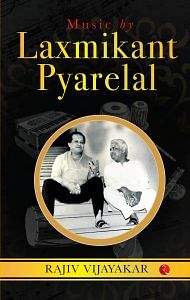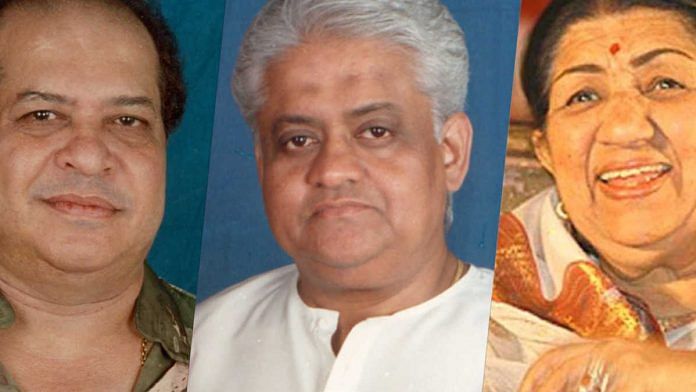Let us rewind to Laxmikant’s firm belief that hard work would always pay. Laxmikant was a musician on the BGM of ShankarJaikishan’s Ayee Milan Ki Bela when its big-name producer J. Om Prakash (Hrithik Roshan’s late maternal grandfather) approached Laxmikant and promised him work for Prakash’s next film, Aaye Din Bahaar Ke. Om-ji, as he was known, had worked with the team of Shankar-Jaikishan-Hasrat-Shailendra in Aas Ka Panchhi and Ayee Milan Ki Bela and Laxmikant had this to say, ‘It was a momentous occasion for us, as the big banner Filmyug was the first of S-J’s banners to come to us. We put everything into this one chance and vindicated Om-ji’s trust in us.’ And when, in an excited first reaction, Laxmikant asked the filmmaker, ‘Can we announce that we are doing your film?’ The filmmaker gently told him to wait until the background score was ready. In an interview, he had told me that he was irritated by S-J’s habit of asking for higher remuneration every time a film was a hit and that he saw in L-P the same potential for the future.
There was one hiccup after the announcement was made: L-P had a sitting again with Hasrat Jaipuri for this new film before S-J came to know and objected to his working there. And so, Anand Bakshi came in. Aaye Din Bahaar Ke (1966), with its allhit soundtrack, created havoc when it was released, and signalled the beginning of an association with the filmmaker that, despite some turbulence in the ’70s, lasted until 1988’s Agnee. It was also the first of over 60 of L-P’s films with emerging star Dharmendra (including four of his home productions and a significant re-creation in a fifth) and a long association with both leading lady Asha Parekh and director Raghunath Jhalani. In 1996, Asha Parekh was to make her debut as a director in L-P’s last musical ace, Bhairavi, but she opted out due to creative differences with the producers and never directed any film.
The hit parade of Aaye Din Bahaar Ke included all-time classics like ‘Suno Sajana’, ‘Meri Dushmun Tu Meri Dosti Ko Tarse’, ‘Yeh Kali Jab Talak Phool’, ‘Khat Likh De Saawariya Ke Naam’, ‘Khudaya Khair’ and ‘Ae Kaash Kisi Deewane Ko’, L-P’s first Lata-Asha duet. ‘Suno Sajana’ remains a cult favourite with connoisseurs. As recently as in 2008, when the song was being performed on stage at Pt Hariprasad Chaurasia’s seventieth birthday celebrations, two girls sitting in front of me, the elder of whom must have been not more than 12 years old, sang the entire lyrics in sync with the singer.
So happy was J. Om Prakash with L-P’s music and professionalism, that he introduced them to other members of United Producers, a consortium that jointly presented films of all its members. Among the United Producers were Mohan Kumar, Subodh Mukerji, Mohan Segal, Shakti Samanta, G.P. Sippy and others. The first three signed them, and G.P. Sippy (who later produced their 1989 film Bhrastachar) offered them Raaz. ‘We had to refuse Raaz as we had too much work!’ smiled Laxmikant. ‘The film, which was Rajesh Khanna’s and Babita’s first release, went to Kalyanji-Anandji and both the film and its music were hits.’
Also read: Remembering Sunil Aiya, legend whose voice dominated Sri Lankan music for 5 decades
One by one, not just S-J loyalists Mohan Kumar and Subodh Mukerji, but even the likes of L.V. Prasad (who was influenced by Tarachand Barjatya) also shifted to L-P and began to form durable associations with the duo. Laxmikant clarified that they had the highest regard for Shankar-Jaikishan. ‘Our industry has never seen and probably will never see composers of their range, calibre and originality,’ he said. But L-P had to prove that they were good too! They wanted to show that they could match S-J with equally good music. Here, Laxmikant also admitted that they started the trend of undercutting. ‘It was simple logic: if you are paying 10 rupees for something and we give you the same quality for two rupees, will you spend more?’ Laxmikant asked me. ‘We simply wanted the best banners and filmmakers.’ And this is where Laxmikant had stressed that they were in a position to give equally excellent music. ‘We were compromising on our price, not on our work, composing original music with our distinctive stamp. Besides, in this industry, you have to keep yourself in the limelight. We had to keep coming out with films, otherwise, we could not hope to survive in a field where two of every three films flop!’
And while saving money is always welcome for a filmmaker, false economy can be counter-productive, and so it was to L-P’s eternal credit that all the banners that moved away from S-J, continued to work with L-P forming long-lasting relationships and even returning to them after doing films with other composers.
By 1969, L-P had given such a consistent stream of hit scores and melodious songs that for the first time in almost two decades, there was an answer, an alternative and a strong challenge to the supremacy of S-J. L-P were declared numero uno by the film trade in 1969 on the strength of their consistency of great music, come hit movie or flop, and their signing with big banners and films with major directors. In the 1966–9 period, L-P still did nine small films too, but their music remained of high calibre. And while they won their second Filmfare award for the L.V. Prasad hit Milan, they also got their first Sur-Singar Samsad award for the Mohammed Rafi gem, ‘Painjaniya Chhanke Ram’ from the small film Wapas (1969), produced and directed by their Dosti director Satyen Bose. This was a prestigious honour from an organization that celebrated Indian classical music, and had instituted a special annual award for the Best Classical Film Song of any year! These awards continued till the late 1980s, and L-P won it again for Ram Lakhan in 1989.
But we are racing ahead again. Let us examine the 1966–9 era in detail.
Also read: HarperCollins is proud to present the autobiography of the musical legend Remo Fernandes
No Room for Complacency
L-P’s love for experimentation with both musical notes and singers was a habit they kept up from the very first day. They experimented with Lata, as their long-standing muse, probably more than with anyone else. Mere Lal, the eight-song score (which included five solos by Lata) for Satyen Bose,21 saw Lata zoom to ethereal heights with the unique ‘Badal Roya Naina Roye’ and hit a popular high with ‘Payal Ki Jhankar Raste Raste’. The film was a modest production starring Dev Kumar and Indrani Mukherjee. Never composers to be bogged down by the branding and image of singers who had been well-entrenched in the industry for almost 20 years, L-P gave Mukesh, often associated with the sad song genre, the frothy ‘Jab Tak Yeh Sansar Nachaye’ in Mere Lal.
A personal observation of critical importance: Gradually, and seemingly primarily with Dosti, the two had also learnt the fine art of making the most impactful sad songs. I firmly believe that a good sad song, while touching the core of the listener’s heart with its musical and lyrical content, should never depress its listener or viewer. Instead, such a song should, simultaneously and paradoxically, invoke admiration for it. No L-P sad song can be found guilty of this aberrational quality that ails so many litanies of every hue from many other composers.
The other 1966 releases were the ensemble cast laugh-riot Pyar Kiye Jaa, the Nutan melodrama Chhota Bhai and AVM’s Laadla (these were their first three films made in Madras), the biggie Aasra, Mala Sinha-Sanjay Khan’s Dillagi, and the modest budgeted Daku Mangal Singh, Naag Mandir and Sau Saal Baad. Each film did well musically, though only Pyar Kiye Jaa, Chhota Bhai and Aasra did commercially well. Among the evergreens were ‘Mere Soone Jeevan Ka Aasra Hai Tu’, ‘Daiyya Re Daiyya’ ‘Neend Kabhi Rehti Thi’, ‘Shokhiyaan Nazar Mein Hai’ (Aasra) and almost the entire score of Pyar Kiye Jaa, considered one of Hindi cinema’s best comedies. Songs like ‘Kisne Pukara Mujhe’, ‘Gore Haathon Par Na Zulm Karo’, ‘O Meri Maina’, ‘Din Jawaani Ke Chaar’, ‘Dil Humne De Diya’, ‘Phool Ban Jaoonga’ and ‘Kehne Ki Nahin Baat’ were all popular. Kishore Kumar was again the hero, though Shashi Kapoor and Mehmood were also prominent figures.
Chhota Bhai was a classic melodrama. By the time it came out, as we have seen, L-P had acquired a mastery over children’s songs as well, thanks to Lata Mangeshkar’s ever-present support. And so, Lata came in to sing the two songs filmed on the protagonist, played by child actor Mahesh Kothare, ‘Na To Hum Darte Hain’ and the classic heart-wrencher ‘Maa Mujhe Apne Aanchal Mein Chhupa Le’. However, the ace in this score was ‘Bhagwan Ne Apne Jaisa’ filmed on Nutan. This devotional song towered in its potent amalgam of philosophical lyrics and deep melody, wondering how, if God had made human beings to resemble him, had they learnt to lie and commit sins (‘Bhagwan ne apne jaisa har ek insaan banaya /Yeh jhooth kidhar se aaye yeh paap kahan se aaya’). This song exemplifies, in a superlative way, the individual mastery and combined synergy of Anand Bakshi’s words and LaxmikantPyarelal’s potent compositions. It served as a perfect illustration of what lyricist Hasrat Jaipuri told me in 1990 for a Mid-Day interview, ‘If we [Shankar-Jaikishan and Hasrat Jaipuri] lost the RK banner with Bobby, I am happy that we lost to the only other great composer-lyricist team in Hindi cinema—Laxmi-Pyare and Anand Bakshi!’
 This excerpt from ‘Music by Laxmikant Pyarelal’ by Rajiv Vijayakar, has been published with permission from Rupa Publications India.
This excerpt from ‘Music by Laxmikant Pyarelal’ by Rajiv Vijayakar, has been published with permission from Rupa Publications India.



